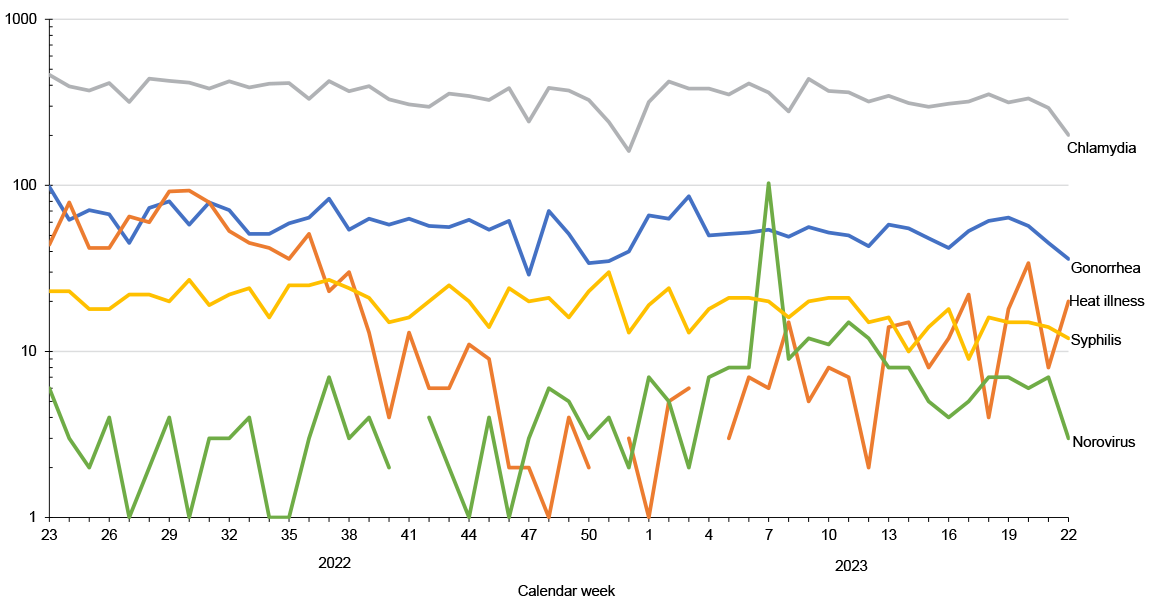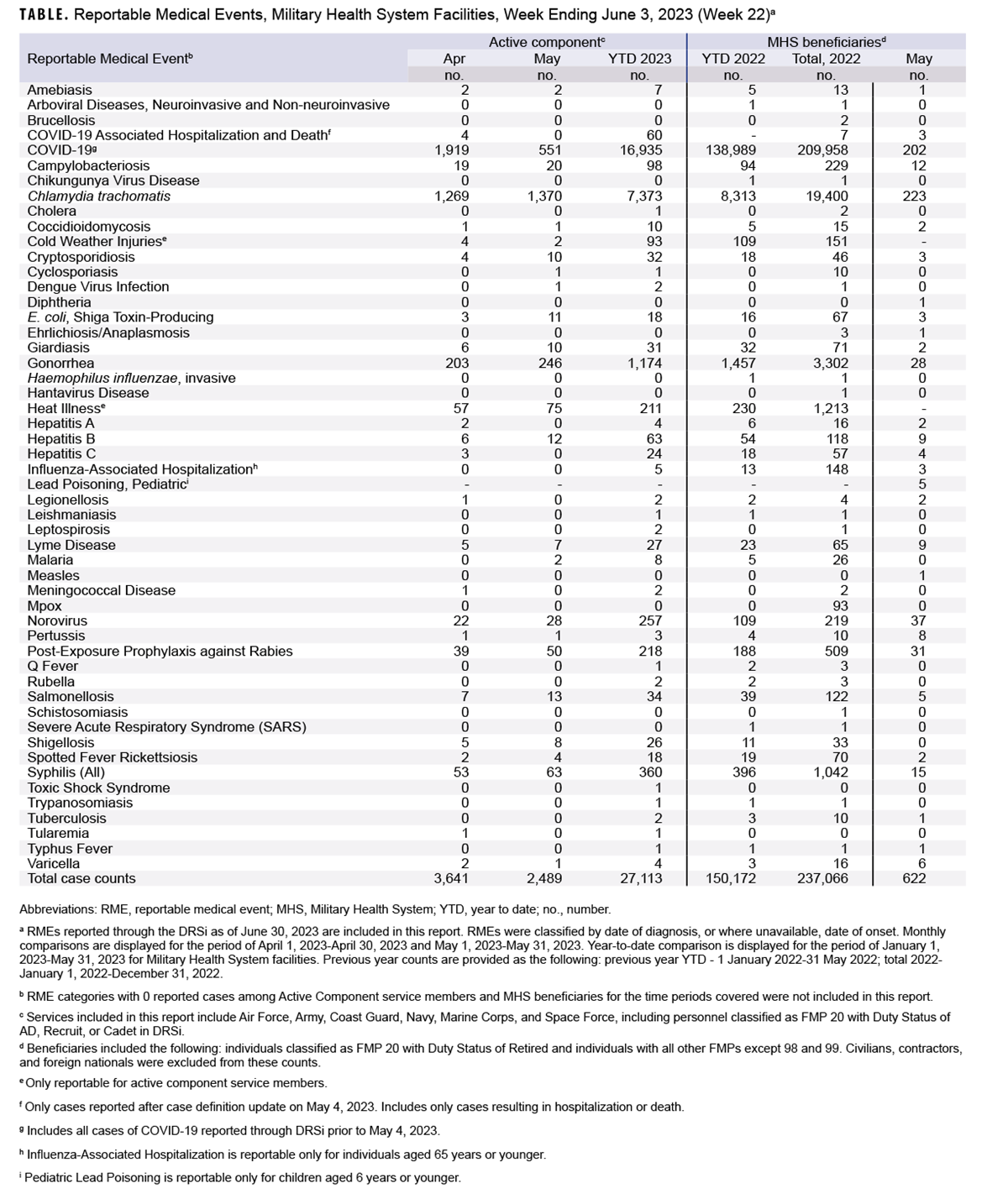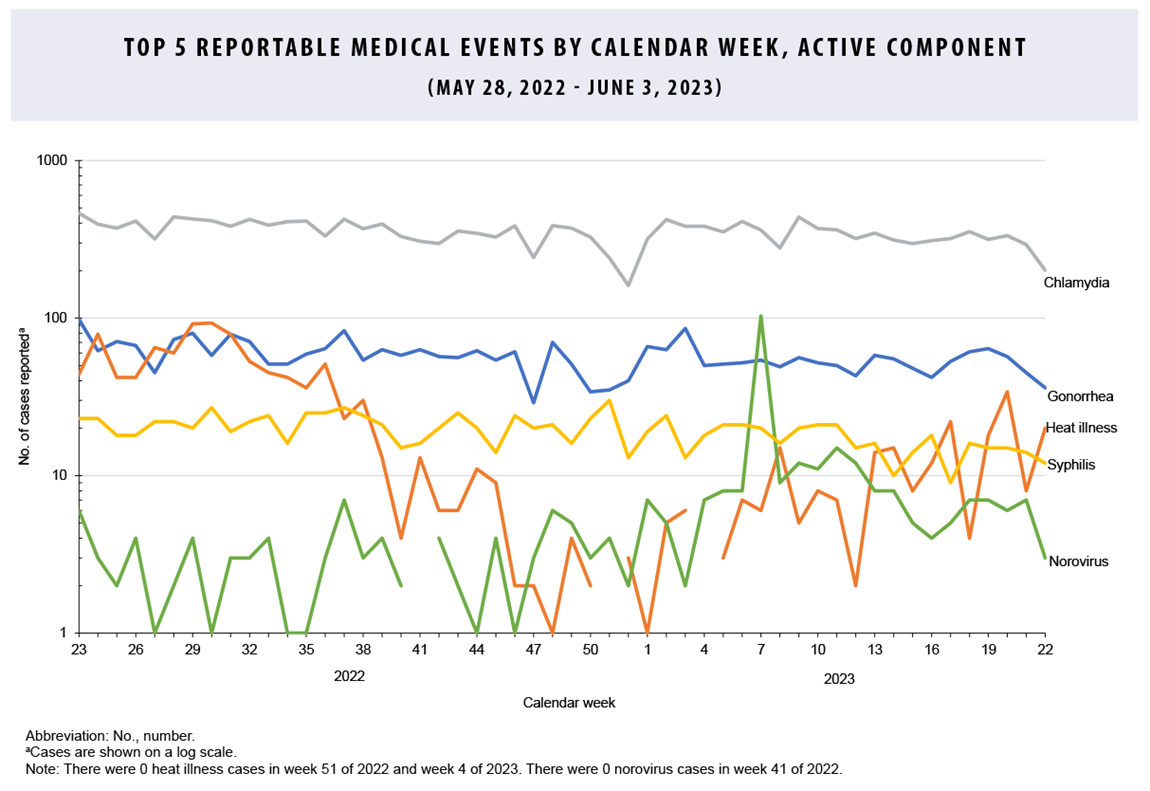Reportable Medical Events, Military Health System Facilities, Week 22, Ending June 3, 2023
 Graph depicting the frequency of the five most common reportable medical events within the Military Health System over the preceding year.
Graph depicting the frequency of the five most common reportable medical events within the Military Health System over the preceding year.
Reportable Medical Events are documented in the Disease Reporting System internet by health care providers and public health officials across the Military Health System for the purpose of monitoring, controlling, and preventing the occurrence and spread of diseases of public health interest or readiness importance. These reports are reviewed by each service’s public health surveillance hub. The DRSi collects reports on over 70 different RMEs, including infectious and non-infectious conditions, outbreak reports, STI risk surveys, and tuberculosis contact investigation reports. A complete list of RMEs is available in the 2022 Armed Forces Reportable Medical Events Guidelines and Case Definitions.1 Data reported in these tables are considered provisional and do not represent conclusive evidence until case reports are fully validated.

Total active component cases reported per week are displayed for the top five RMEs for the previous year. Each month, the graph is updated with the top five RMEs, and is presented with the current month’s (May 2023) top five RMEs, which may differ from previous months. COVID-19 is excluded from these graphs due to changes in reporting/case definition updates in 2023.

References
- Armed Forces Health Surveillance Division. Armed Forces Reportable Medical Events. Accessed April 6, 2023. https://www.health.mil/Military-Health-Topics/Health-Readiness/AFHSD/Reports-and-Publications/Armed-Forces-Reportable-Medical-Events
- Defense Manpower Data Center. Department of Defense Active Duty Military Personnel by Rank/Grade of Service, October 31, 2022. https://dwp.dmdc.osd.mil/dwp/app/dod-data-reports/workforce-reports
- Defense Manpower Data Center. Armed Forces Strength Figures for January 31, 2023. https://dwp.dmdc.osd.mil/dwp/app/dod-data-reports/workforce-reports
- Navy Medicine. Surveillance and Reporting Tools–DRSI: Disease Reporting System Internet. https://www.med.navy.mil/Navy-Marine-Corps-Public-Health-Center/Preventive-Medicine/Program-and-Policy-Support/Disease-Surveillance/DRSI
You also may be interested in...
Fact Sheet
Nov 6, 2023
 .PDF |
895.85 KB
.PDF |
895.85 KB
This TBICoE fact sheet, Warfighter Brain Health After TBI: Guidance for Leaders, condenses the basics of recognizing, reporting, and preventing TBI in service members. It updates and supersedes the Line Leader Policy Guidance fact sheet and includes a list of what the DOD has defined as potentially concussive events and outlines leaders’ ...
Fact Sheet
May 12, 2022
 .PDF |
160.12 KB
.PDF |
160.12 KB
This document shows the flow chart for how the PDBR processes requests for reviews of disability ratings.
Fact Sheet
Apr 7, 2021
 .PDF |
751.64 KB
.PDF |
751.64 KB
Additional information about the TCCC ASM CM course for potential students to review.
Fact Sheet
Jan 8, 2021
 .PDF |
80.83 KB
.PDF |
80.83 KB
A reference for potential EWSC students.
Fact Sheet
May 12, 2017
 .PDF |
224.93 KB
.PDF |
224.93 KB
This fact sheet provides a system overview of the Defense Medical Epidemiology Database (DMED). DMED is a web-based tool to remotely query de-identified active component personnel and medical event data contained within the Defense Medical Surveillance System (DMSS). Learn about the newly released version of DMED and its key features in this document.
Fact Sheet
Mar 30, 2017
 .PDF |
283.00 KB
.PDF |
283.00 KB
This fact sheet provides details on the demographic and military traits of service members diagnosed as traumatic brain injury (TBI) cases during a 16-year surveillance period from 2001 through 2016, a total of 276,858 active component service members received first-time diagnoses of TBI - a structural alteration of the brain or physiological ...
Fact Sheet
Mar 30, 2017
 .PDF |
313.80 KB
.PDF |
313.80 KB
This fact sheet provides details on Rhabdomyolysis by location for active component, U.S. Armed Forces during a five-year surveillance period from 2012 through 2016. The medical treatment facilities at nine installations diagnosed at least 50 cases each and, together approximately half (49.9%) of all diagnosed cases.
Fact Sheet
Mar 30, 2017
 .PDF |
267.04 KB
.PDF |
267.04 KB
This fact sheet provides details on heat illnesses by location during a five-year surveillance period from 2012 through 2016. 11,967 heat-related illnesses were diagnosed at more than 250 military installations and geographic locations worldwide. Three Army Installations accounted for close to one-third of all heat illnesses during the period.
Fact Sheet
Feb 3, 2016
 .PDF |
401.93 KB
.PDF |
401.93 KB
Zika (zee-kah) virus is primarily spread from an infected person to an uninfected person through the bite of an infected Aedes species mosquito. Although most infections do not cause symptoms, Zika virus infection may result in fever, rash, joint pain, and red eyes.
Fact Sheet
Nov 4, 2014
 .PDF |
2.54 MB
.PDF |
2.54 MB
The President and the Secretary of Defense have called upon the men and women of the US armed forces and other government personnel to provide critical support as part of the international response to the Ebola outbreaks in West Africa. This Fact Sheet highlights the actions that are in place prior to, during, and after deployment in order to protect ...
Fact Sheet
Oct 10, 2014
 .PDF |
102.28 KB
.PDF |
102.28 KB
A fact sheet from the Centers for Disease Control describing Ebola, transimission, signs and symptoms, risk of exposure, diagnosis, treatment and prevention.
Fact Sheet
May 4, 2005
 .PDF |
160.05 KB
.PDF |
160.05 KB
The Medical Countermeasures (MCM) Directorate assists in protecting U.S. forces that are globally engaged and at potentially increased risk to being exposed to naturally occurring substances or encountering manufactured chemical, biological, radiological or nuclear (CBRN) agents that adversaries may seek to use against them.
You are leaving Health.mil
The appearance of hyperlinks does not constitute endorsement by the Department of Defense of non-U.S. Government sites or the information, products, or services contained therein. Although the Defense Health Agency may or may not use these sites as additional distribution channels for Department of Defense information, it does not exercise editorial control over all of the information that you may find at these locations. Such links are provided consistent with the stated purpose of this website.
You are leaving Health.mil
View the external links disclaimer.
Last Updated: August 24, 2023